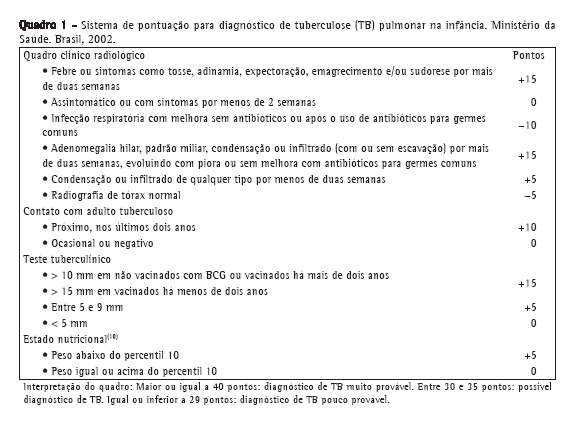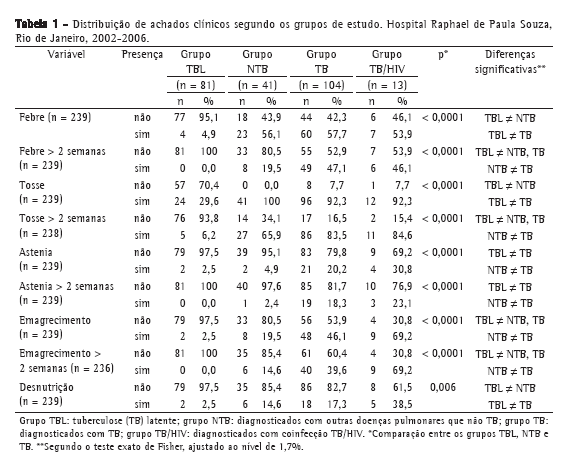

Cinthia Pedrozo, Clemax Couto Sant'Anna, Maria de Fátima B. Pombo March, Sheila Cunha Lucena
ABSTRACT
Objective: To determine the efficacy of the scoring system, recommended by the Brazilian National Ministry of Health (NMH), for the diagnosis of pulmonary tuberculosis (TB) in children and adolescents, regardless of their HIV status. Methods: This was a cross-sectional analytical study carried out between January of 2002 and December of 2006, involving 239 individuals less than 15 years of age. The patients were divided into four groups: latent TB (LTB group; n = 81); no-TB (NTB group; n = 41); TB group (n = 104); and TB/HIV group (n = 13). We studied the clinical, radiological and laboratory findings according to the scoring system. Results: Reports of fever, cough, asthenia and weight loss for at least two weeks were significantly higher in the TB group (p < 0.0001). The proportion of cases with a history of any contact and household contact with a TB patient was, respectively, 95.0% and 86.1% in the TB group, versus 75.0% and 58.3% in the TB/HIV group. In the TB and TB/HIV groups, respectively, chest X-rays revealed parenchymal alterations in 75.0% and 53.9%, revealing combined parenchymal/lymph node alterations in 18.2% and 30.8%. There were no significant differences among the groups regarding the tuberculin skin test results. In the TB group, 16.3% of the patients were malnourished (p < 0.005 vs. the LTB group). The mean NMH system scores in the LTB, NTB, TB and TB/HIV groups were, respectively, 24.2, 18.5, 45.3 and 41.5. Conclusions: The NMH system scores were significantly higher in the TB and TB/HIV groups than in the other two groups. Therefore, this scoring system was valid for the diagnosis of pulmonary TB in this population, regardless of HIV status.
Keywords: Tuberculosis/diagnosis; HIV seropositivity; Diagnostic techniques and procedures.
RESUMO
Objetivo: Verificar a eficácia do sistema de pontuação, preconizado pelo Ministério da Saúde (MS), para o diagnóstico de TB pulmonar em crianças e adolescentes, infectadas ou não pelo HIV. Métodos: Estudo analítico transversal realizado entre janeiro de 2002 e dezembro de 2006, no qual foram incluídos 239 indivíduos menores de 15 anos. Os pacientes foram divididos em quatro grupos: grupo TB latente (TBL; n = 81); grupo não TB (NTB; n = 41); grupo TB (n = 104); e grupo TB/HIV (n = 13). Foram estudadas as características clínicas, radiológicas e laboratoriais segundo o sistema de pontuação. Resultados: Os relatos de febre, tosse, astenia e emagrecimento há mais de duas semanas foram significativamente maiores no grupo TB (p < 0,0001). No grupo TB, 95,0% dos casos tinham história de contato com indivíduo com TB, sendo que em 86,1% esse contato era intradomiciliar. No grupo TB/HIV, 75,0% dos casos haviam entrado em contato com TB e, em 58,3%, esse contato era intradomiciliar. Nos grupos TB e TB/HIV, respectivamente, 75,0% e 53,9% dos casos apresentaram alterações radiológicas parenquimatosas, enquanto 18,2% e 30,8% apresentaram alterações ganglionares e parenquimatosas. Os resultados da prova tuberculínica não apresentaram diferenças significativas entre os grupos. No grupo TB, 16,3% dos pacientes estavam desnutridos (p < 0,005 vs. o grupo TBL). A pontuação média utilizando o sistema MS foi a seguinte: grupo TBL, 24,2; grupo NTB, 18,5; grupo TB, 45,3; e grupo TB/HIV, 41,5. Conclusões: Os pacientes dos grupos TB e TB/HIV apresentaram pontuação significativamente maior do que aqueles nos outros grupos. Portanto, esse sistema de pontuação foi válido para o diagnóstico de TB pulmonar nessa população, independentemente do status HIV.
Palavras-chave: Tuberculose/diagnóstico; Soropositividade para HIV; Diagnóstico.
b>Introdução

